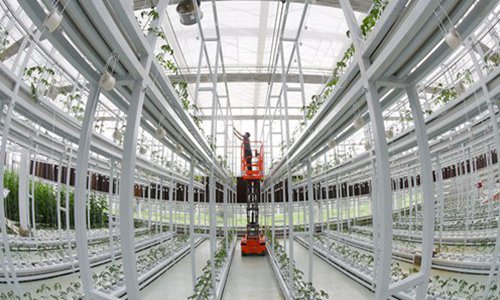HOME >> BUSINESS
Despite diverse land, China now provides 1.4 billion people with year-round vegetables
By Global Times – Xinhua Source:Global Times - Xinhua Published: 2019/9/18 18:38:40

An employee inspects vegetables at a greenhouse in an intelligent agricultural industrial park in Lianyungang, East China's Jiangsu Province on Wednesday. The park has 22 such greenhouses and aims to combine Internet of Things technology with daily management of the greenhouses. Photo: IC
Over the past decade, China's vegetable production has increased and has always been the world's largest.Thanks to the six large key vegetable production areas and technologies such as greenhouse and vegetable breeding, China now can provide its 1.4 billion people with fresh vegetables all year round, despite the country's diverse land and weather conditions.
Mohe, China's northernmost city, winter temperatures can drop to below -40 C. In Western China's Tuokexun, there are only nine days of rainfall on average each year. The Qinghai-Tibet Plateau in Southwest China has an average elevation of more than 4,000 m.
Despite its diverse land conditions, 1.4 billion Chinese people are still able to eat vegetables all year round. How can this be?
In Northern China, temperatures drop rapidly in autumn and soil gradually freezes in winter. Outdoor plants cannot be grown for five to six months. But science and technology has solved this problem.
From 2006 to 2016, the planting area for China's greenhouse vegetables has grown by an average of about 1.6 million mu (107,000 hectares) per year - nearly the size of Los Angeles in the US.
The planting environment in greenhouses has been improved by science and technology. Solutions such as automatic irrigation and ventilation are made possible through intelligent systems that monitor factors like light, heat and pests.
By improving vegetable breeding, China's vegetables are of higher quality, more disease-resistant and have higher yields.
In saline and alkaline land, improved water bamboo can produce 2,000 kg per mu annually.
Additionally, farmers across China are now reducing the use of pesticides and fertilizers.
The government also guarantees land areas for agricultural production through legislation and other means. It resolutely prohibits the use of such land for, among other uses, the construction of houses.
While maintaining its top position in terms of quantity, China also wants to be the champion of vegetable quality.
Vegetable production is also becoming increasingly automated and more accurate.
In China, this change in production and economic model is called supply-side structural reform. Adjusting production sources has provided consumers with better-quality vegetables. Such reform will bring increased quantities of, and better, vegetables to China and the world.
Posted in: ECONOMY